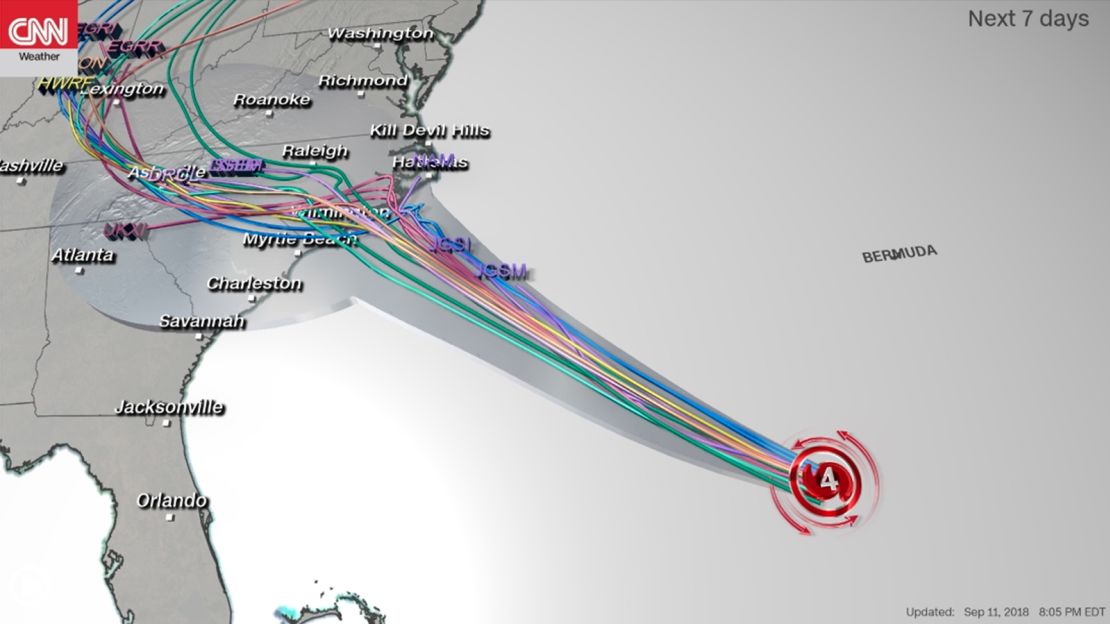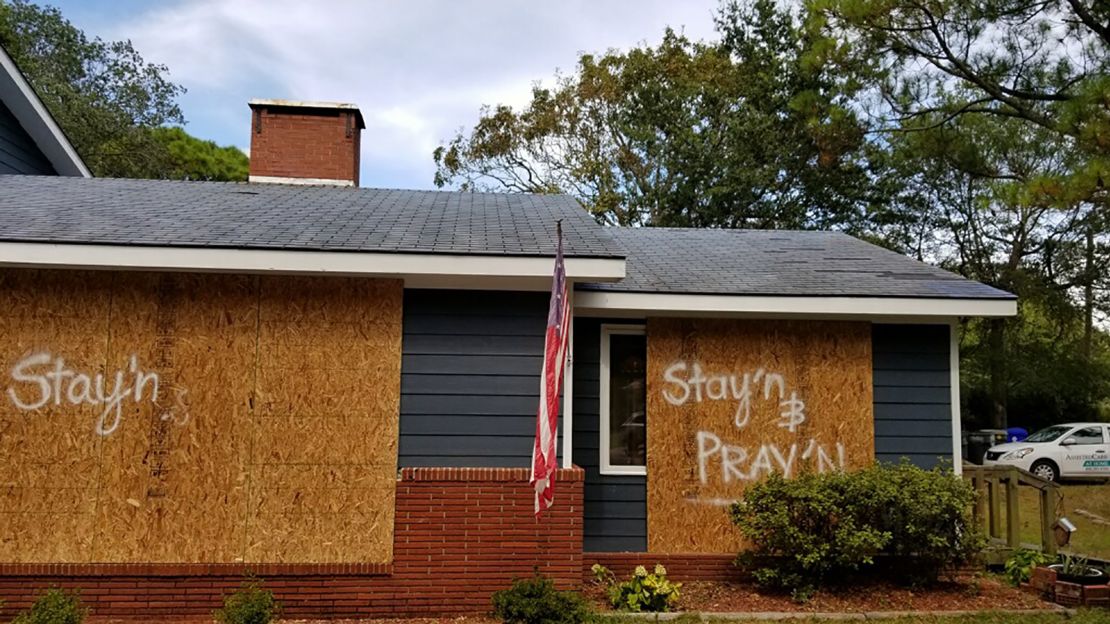Editor’s Note: How are you preparing for Hurricane Florence? Text, iMessage or WhatsApp your videos, photos and stories to CNN: 347-322-0415
With a Category 4 hurricane rapidly approaching and weather officials issuing a hurricane warning for more than 300 miles of coastline, more than 1 million people faced a choice Tuesday: stay home and take their chances with the storm, or compete with heavy traffic to drive inland.
The National Weather Service said Hurricane Florence will bring life-threatening storm surge and rainfall to parts of the Carolinas and Mid-Atlantic states.
And despite mandatory evacuation orders in coastal areas of North Carolina, South Carolina, and Virginia, many residents haven’t decided to leave.
Tropical-storm-force winds are due to reach the coasts of North and South Carolina on Thursday morning, and hurricane-force winds may be felt around Thursday night, ahead of an anticipated Friday morning landfall.
Florence is one of the strongest hurricanes to churn toward the eastern seaboard in decades.
Tim Terman and his wife live in Southport, near Bald Head Island, North Carolina.
His family members have been pressuring him to evacuate, he said, but he is staying put – for now.
“Once you leave, (it will be) hard to get back in to check on damage,” he told CNN. “My home is all my wife and I have, materially speaking, a lifetime of stuff.” They say their house is about 20 feet above sea level.
Terman, who said his wife already had plans to take a trip, will make his final decision Wednesday.
Latest developments
• As of 8 p.m. ET Tuesday, Florence’s center had maximum sustained winds of 140 mph and was about 725 miles east-southeast of Cape Fear, North Carolina.
• The National Hurricane Center issued a hurricane warning for the coast from to Duck, North Carolina, and the Albemarle and Pamlico Sounds, to the South Santee River, South Carolina. Hurricane warnings are issued 36 hours before tropical storm force winds hit the areas, and indicate hurricane conditions will follow.
• Florence strengthened Tuesday, though it should weaken to a Category 3 storm by landfall around Friday morning, likely in the Carolinas, forecasts show.

• Still, it will “be an extremely dangerous major hurricane” through landfall, the National Hurricane Center said.
• President Trump declared an emergency in North Carolina, allowing it to access federal funds. “I think that any amounts of money, whatever it takes, we’re going to do,” Trump said.
• Later this week, life-threatening storm surges – up to 13 feet – are expected along the coasts, and up to 35 inches of rain could fall through early next week over parts of the Carolinas and Mid-Atlantic states.
• The storm’s center may move very slowly inland – meaning rain for days in some places. “This thing is going to stop, and it’s going to rain – and it’s going to rain. … We could see 3 feet,” CNN meteorologist Chad Myers said Tuesday afternoon.
• Mandatory evacuations have been ordered for most of the South Carolina coastline, in Edisto Beach as well as from Charleston County northeast to Horry County. They’ve also been ordered for parts of coastal North Carolina and Virginia.
• The state of North Carolina lists 20 shelters open in eastern counties. It also said prisoners from four jails have been moved farther inland.
• North Carolina-based Lowe’s home improvement stores say the most popular items right now are generators, chainsaw, buckets, trash bags, tarps, plywood and gas cans.

• Powerful storm surges and winds will pose deadly threats, as will long periods of heavy rain. Beyond the Carolinas and Virginia, the threat of flooding extends into next week to parts of Georgia, Maryland, Ohio, Pennsylvania, Tennessee, West Virginia, forecasters said.
Residents prepare to flee and hunker down
“This will be a storm that creates and causes massive damage to our country,” Jeff Byard, Federal Emergency Management Agency associate administrator, said Tuesday.
“It is going to be … a long-term recovery,” Byard said. “This is not going to be a storm that we recover from in days.”
Residents along the coast boarded up their homes, formed long lines at gas stations and emptied the shelves of hardware stores and supermarkets this week as they prepared for Florence’s arrival.
On Ocracoke Island along North Carolina’s Outer Banks, Kelley Shinn’s partner woke her up at 3 a.m. Tuesday and told her to pack. He figured the forecasts were too ominous to stay.

They and their 12-year-old packed her Jeep with clothes and other things, and within hours, they took a ferry to the mainland, then struck out for her father’s home in Ohio.
“It’s surreal to think we may have nothing to go home to,” she told CNN. ” … We’ve never left for a storm before. But a storm surge of 20 feet could easily wipe this island out.”
John McGowan, a resident of a town just west of Wilmington, said Tuesday he planned on staying through the storm – but filled his vehicle with gas in case he changes his mind.
“I’ll make an evaluation tomorrow (Wednesday) afternoon. If that thing is still coming at us at about 120 mph, I may change my mind,” he said.
In Wilmington, Anita Harrell said she waited 90 minutes at a Home Depot on Tuesday to get plywood, intending to board up her home and business.
The store, she said, was starting to run out, and was limiting each customer to 12 pieces.
The mayor of Carolina Beach, a small town near Wilmington with a permanent population of about 6,300, said he thinks half of the community’s residents have stayed on the island, which also includes Kure Beach.
The Snow’s Cut Bridge, which is the only point of entry to the island, will close once winds reach 45 mph at the structure, Mayor Joe Benson said.
States of emergency declared in four states
One year after major storms ravaged the Gulf Coast and Puerto Rico, officials warned those in Florence’s path not to underestimate the threat the storm poses.
States of emergency were declared in the Carolinas; Virginia;Washington, DC; and Maryland, where some coastal areas are still recovering from summer storms.
“We are hoping for the best and preparing for the worst,” Maryland Gov. Larry Hogan said, noting that Florence could cause catastrophic flooding in his state.
North Carolina Gov. Roy Cooper on Tuesday urged people to make preparations and heed evacuation orders, warning that electrical service could be lost for several days, and days of heavy rain could lead to severe flooding in many areas.
“The time to hope Hurricane Florence away is gone,” he said.
In South Carolina, traffic in all lanes of Interstate 26 from Charleston to Columbia has been directed away from the coast, South Carolina Gov. Henry McMaster said.
Traffic also has been directed away from the coast on parts of US 501, McMaster said.
In Virginia, mandatory evacuations began Tuesday morning for about 245,000 residents in a portion of Hampton Roads and the Eastern Shore area.
National Guard soldiers are being mobilized in the affected states.
Kaylee Hartung reported from Wilmington. Jason Hanna and Steve Almasy wrote in Atlanta. Susannah Cullinane, Emanuella Grinberg, Paul P. Murphy, David Williams, Keith Allen, Kevin Liptak, Janet DiGiacomo, Amanda Jackson and Hollie Silverman contributed to this report.






















